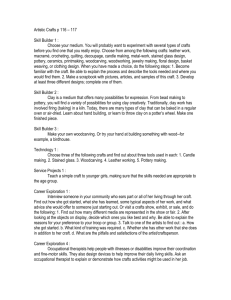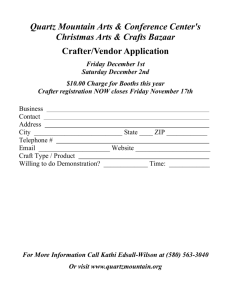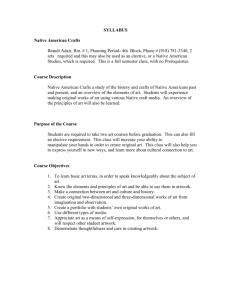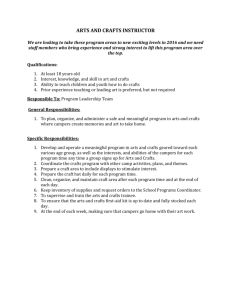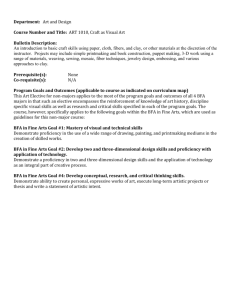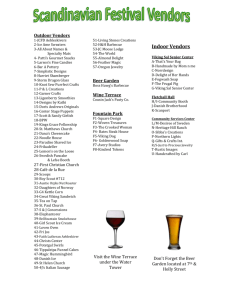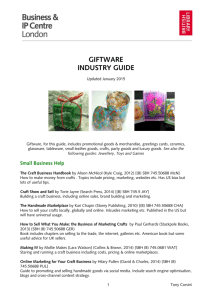Crafts I Helen Lockwood
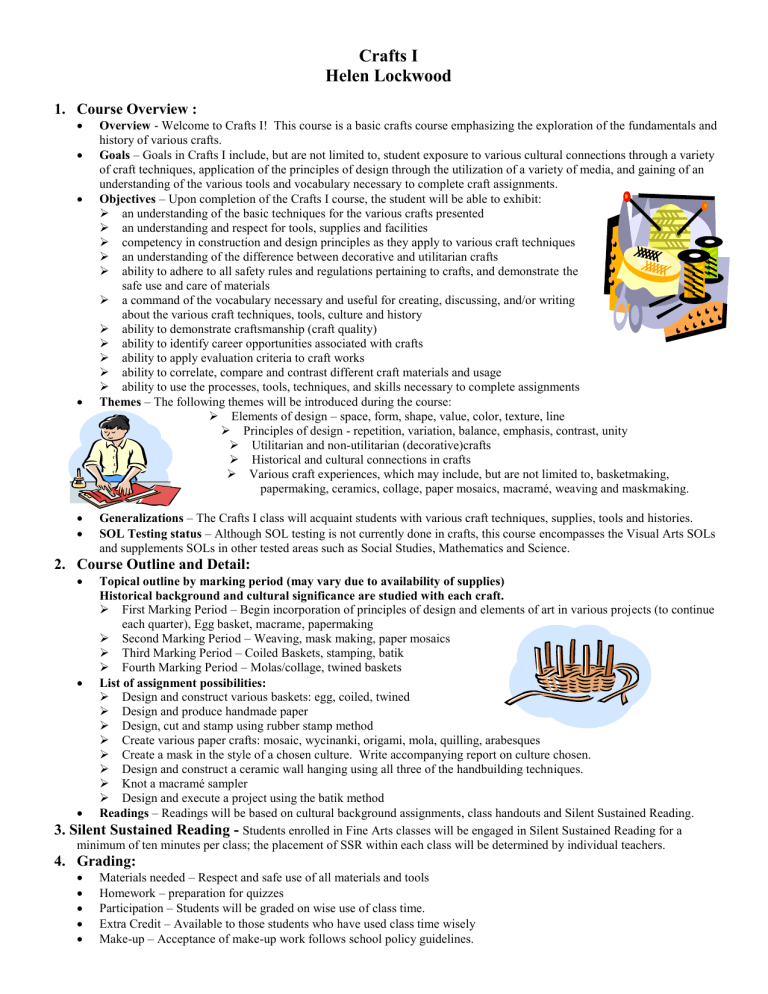
Crafts I
Helen Lockwood
1.
Course Overview :
Overview - Welcome to Crafts I! This course is a basic crafts course emphasizing the exploration of the fundamentals and history of various crafts.
Goals – Goals in Crafts I include, but are not limited to, student exposure to various cultural connections through a variety of craft techniques, application of the principles of design through the utilization of a variety of media, and gaining of an understanding of the various tools and vocabulary necessary to complete craft assignments.
Objectives – Upon completion of the Crafts I course, the student will be able to exhibit:
an understanding of the basic techniques for the various crafts presented
an understanding and respect for tools, supplies and facilities
competency in construction and design principles as they apply to various craft techniques
an understanding of the difference between decorative and utilitarian crafts
ability to adhere to all safety rules and regulations pertaining to crafts, and demonstrate the safe use and care of materials
a command of the vocabulary necessary and useful for creating, discussing, and/or writing about the various craft techniques, tools, culture and history
ability to demonstrate craftsmanship (craft quality)
ability to identify career opportunities associated with crafts
ability to apply evaluation criteria to craft works
ability to correlate, compare and contrast different craft materials and usage
ability to use the processes, tools, techniques, and skills necessary to complete assignments
Themes – The following themes will be introduced during the course:
Elements of design – space, form, shape, value, color, texture, line
Principles of design - repetition, variation, balance, emphasis, contrast, unity
Utilitarian and non-utilitarian (decorative)crafts
Historical and cultural connections in crafts
Various craft experiences, which may include, but are not limited to, basketmaking, papermaking, ceramics, collage, paper mosaics, macramé, weaving and maskmaking.
Generalizations – The Crafts I class will acquaint students with various craft techniques, supplies, tools and histories.
SOL Testing status – Although SOL testing is not currently done in crafts, this course encompasses the Visual Arts SOLs and supplements SOLs in other tested areas such as Social Studies, Mathematics and Science.
2.
Course Outline and Detail:
Topical outline by marking period (may vary due to availability of supplies)
Historical background and cultural significance are studied with each craft.
First Marking Period – Begin incorporation of principles of design and elements of art in various projects (to continue each quarter), Egg basket, macrame, papermaking
Second Marking Period – Weaving, mask making, paper mosaics
Third Marking Period – Coiled Baskets, stamping, batik
Fourth Marking Period – Molas/collage, twined baskets
List of assignment possibilities:
Design and construct various baskets: egg, coiled, twined
Design and produce handmade paper
Design, cut and stamp using rubber stamp method
Create various paper crafts: mosaic, wycinanki, origami, mola, quilling, arabesques
Create a mask in the style of a chosen culture. Write accompanying report on culture chosen.
Design and construct a ceramic wall hanging using all three of the handbuilding techniques.
Knot a macramé sampler
Design and execute a project using the batik method
Readings – Readings will be based on cultural background assignments, class handouts and Silent Sustained Reading.
3. Silent Sustained Reading -
Students enrolled in Fine Arts classes will be engaged in Silent Sustained Reading for a minimum of ten minutes per class; the placement of SSR within each class will be determined by individual teachers.
4.
Grading:
Materials needed – Respect and safe use of all materials and tools
Homework – preparation for quizzes
Participation – Students will be graded on wise use of class time.
Extra Credit – Available to those students who have used class time wisely
Make-up – Acceptance of make-up work follows school policy guidelines.
Exams – Periodic quizzes will be administered. First semester exam is mandatory and comprehensive.
Second semester exam is subject to exemption policy.
Summarizers – Student participation in the clean up and summarization of each class is a portion of student grade.
Craftsmanship, timely completion of each project, wise use of class time and meeting of each project’s requirements are a substantial portion of each grade.
Participation in self evaluation and class discussions will be included in grade.
5. Exam Exemptions
: Students in all courses may be exempted from their final exam if they meet the following criteria:
1.
Grade average of 90% or above
2.
No in-school or out-of-school suspensions.
6.SOL Exam Substitution/Exam Exemption:
Only students enrolled in Practical, Standard, Academic, Advanced level courses will be exempted from their final exam and substitute an SOL end-of-course exam for the final exam.
7. Grading Scale
: The Division’s grading scale is a 10-point scale.
A: 90 – 100 B: 80 – 89 C: 70 – 79 D: 60 – 69 F: 0 – 59
8. Discipline Plan
Expected Behaviors – Students are expected to:
Arrive at class on time, with appropriate materials as necessary
Work consistently throughout class
Begin the DO NOW assignment immediately
Adhere to all rules and regulations as outlined in the student handbook
Demonstrate respectful behavior to both teacher and other students
Show respect for materials, tools and facility
Refrain from abusive or vulgar language
Clean all tools and workspace as requested
Rewards - Written and verbal commendations are given. Class cooperation with all expected behaviors may result in the use of appropriate “background music.”
Consequences – Consequences may vary depending upon type of infraction. Students choosing not to adhere to classroom rules may expect one or more of the following:
Student/teacher conference
Telephone call to parent
Conference with parent
Office referral
Honor Code – All students are expected to rigorously follow the Monticello High School honor code. Cheating, stealing, plagiarism, lying, forgery, and repeated abuses of technology may come before the honor council who will determine the legitimacy of the violation and consequences. It is especially important that you understand what cheating is. During the course of the year, I will sometimes ask you to pledge your work or portions of it. This could be a test, a project, lab work, or other school related assignments. When you write pledge on your work, it is understood that you did the assignment independently without any assistance from anyone else or without using unapproved books or study aids.
9.Silent Sustained Reading –
Students enrolled in Fine Arts classes will be engaged in Silent Sustained Reading for a minimum of ten minutes per class; the placement of SSR within each class will be determined by individual teachers.
10.Student Planner
The primary function of the student planner is to teach organizational skills and time management. It must be used for recording assignments in all classes. A secondary function is for hall passes. STUDENTS WILL BE EXPECTED TO
HAVE PLANNERS WITH THEM AT ALL TIMES!
11.Teacher Contact
Ms. Helen Lockwood; Email address – hlockwood@k12albemarle.org
; Telephone – school - (434) 244-
3100
12.Appendices
Student work done by Monticello High School artists is often photographed, exhibited and displayed throughout the school and community. In addition, students are often photographed for educational demonstration purposes while working on classroom assignments. IF YOU DO NOT WISH YOUR STUDENT TO BE PHOTOGRAPHED OR DO NOT
WISH THE WORKS OF YOUR STUDENT(S) TO BE EXHIBITED, PHOTOGRAPHED OR DISPLAYED,
PLEASE CONTACT ME IMMEDIATELY, IN WRITING, AT THE ABOVE SCHOOL ADDRESS.
We are excited to pilot the “parent portal” through PowerSchool during the second semester at Monticello. This portal will give students and parents access to student grades and attendance via the Internet. Teachers will update grades in the parent
portal at a minimum of every other week.
